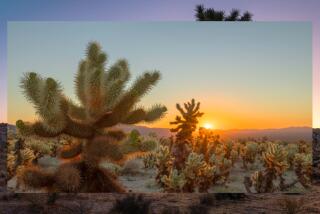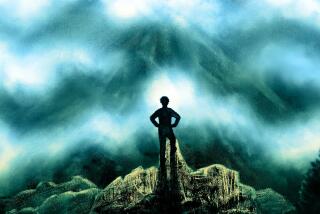The mystique of Sedona
Mysteries dwell within the towering red rocks of northern Arizona. And it doesn’t take a Sedona visitor long to stumble upon them.
“The woo-woo factor is strong here,” psychic Craig Junjulas told me the morning I arrived.
“Huh?” I said, doing a double take; I was pretty sure he had said woo-woo, the moaning sound kids make when they imitate ghosts (as opposed to whoo-whoo, the singsong sound they make when pretending to be a train).
“You know, mystical things,” he said, vaguely.
I had come to Sedona seeking beauty and had found it in the region’s soaring red monoliths and in the rushing waters of Oak Creek. Long considered one of the most scenic cities in the Southwest, Sedona can hold its own among the nation’s national parks, including the Grand Canyon, about 2 1/2 hours north.
But Sedona has other attributes too. It may be the only place in the nation where you can get a psychic massage at your hotel, buy “healing crystals” at a burger joint or wear a purple wizard’s hat to dinner without drawing stares.
More than a quarter of a century after vortexes -- energy fields with purported healing powers -- were said to exist here, this mystical New Age destination remains unapologetically wacky. In fact, the city’s signature quirkiness draws a significant part of the 3.5 million tourists who visit annually. And in today’s topsy-turvy world, who’s to say a little woo-woo isn’t a good thing?
When I visited a few months ago, I tried to keep an open mind and heart. I would become an acolyte in search of self-discovery. And if that didn’t pan out, I hoped at least to be able to report some cool-sounding mumbo jumbo.
I found it almost immediately, atop a stunning red sandstone rock formation southwest of downtown Sedona. It was a sweet benediction led by Feather Jones, a fiftysomething herbalist and guide.
“I give thanks to Earth Mother for nourishment and support and to Sky Father for the air we breathe. . . . “
We’d been climbing a nearly vertical slope for about 30 minutes when Jones stopped on a level sandstone shelf, said her prayer and sprinkled herbs from a leather bag.
The trail had been slippery and harrowing in spots, a steep climb that gained 600 feet in about half a mile. It went straight up the side of the rock, forcing me to clamber upward using hands, feet and posterior to keep from falling. But the view was spectacular: The green bowl of Sedona is rimmed by luminous crimson peaks and set off by a brilliant blue sky. A hawk circled and soared while I absorbed the vibe and tried not to get too close to the edge.
We were near a vortex, Jones said. Could I feel the healing energy? No. But the scenery was beautiful enough to make me feel as though I were in an open-air house of worship. Jones urged me to say my own prayer, to make an intention for the day.
“I intend that I am healthy and strong and balanced,” I said aloud. “And that I not slip off the rocks on the way down and kill myself.” Heartfelt, if not eloquent.
Cathedral Rock, the formation we’d been climbing, is one of several sandstone monoliths -- the Red Rocks of Sedona -- that ring this city of 11,500. The formations have descriptive names -- Coffee Pot, Snoopy and Bell Rock -- and provide an awe-inspiring backdrop for an array of outdoor activities, including hiking, mountain biking, four-wheeling and otherworldly pursuits.
Bell Rock was ground zero for many of those who came here in 1987 for the Harmonic Convergence, a pseudo-religious event that drew believers to mystical places throughout the world. Thousands arrived in Sedona for the meeting, hoping for a global awakening of harmony and love. Many gathered on or near Bell Rock, waiting for its top to slide open and a flying saucer to glide out. When it didn’t, they just partied on.
Some have been partying ever since. The town’s substantial contingent of New Age devotees and practitioners includes some aging hippies who arrived for the convergence and never left.
They and other metaphysical therapists offer an array of services: crystal healing; psychic, aura and tarot readings; spirit dancing; vortex tours; and soul counseling. They even have their own professional organization, the Sedona Metaphysical Spiritual Assn.; among the membership are therapists who advertise brain enhancements, past life regression and sacred soul journeys. Some of the therapies are loosely linked to Native American beliefs.
Indeed, Native American influence has been strong here for centuries; Indians called the area a sacred place long before Anglos arrived. Petroglyphs, pictographs and cliff dwellings still can be found in the region.
The farmers and ranchers who homesteaded here began to move into the region in the late 19th century; many lived along scenic Oak Creek. The town took its name from Sedona Schnebly, an early settler’s wife. By the 1920s, Hollywood had discovered the region’s potential; among the nearly 100 films made here are “Tall in the Saddle” with John Wayne (1944) and “Broken Arrow” with James Stewart (1950).
One of the region’s most popular back-country trails is named for the Stewart film. After my experience dangling off the cliffs of Cathedral Rock, I wimped out and took a Pink Jeep off-road tour to explore the Broken Arrow Trail as it winds through sandstone monoliths in Coconino National Forest (two hours, $75 for adults, $56 for children, [800] 873-3662, www.pinkjeep.com).
It was scarier than the hike. The Jeep went straight up -- and down -- the rocks, sometimes at a 45-degree angle. I held on tight, my heart hammering as we skirted the edge of sheer cliffs, maneuvering over the sculpted, weathered red sandstone that locals call slick rock.
“I’m going to close my eyes,” I screamed at John Domaska, the driver. “I won’t be offended,” he replied. “I do it all the time.”
We traveled over rocks stained with desert varnish and skirted groves of Arizona cypress. We finally took a break at Chicken Point, a slick-rock pass between two high buttes. The view was amazing: vivid rock pinnacles and miles of pinyon pine and juniper.
On the trip back, I asked Domaska, a native of Arcadia who has lived in Arizona for 16 years, what he thought about vortexes.
“They were made up by a psychic,” he said, laughing.
And he doesn’t think much of the quirkier aspects of life in Sedona.
“I don’t believe in any of that. Not the vortexes, not the crystals-will-cure-you stuff, not the aliens-have-landed here stuff.
“But it’s really a beautiful place.”
Back in the city, I took a walk around uptown Sedona, where souvenir shops and restaurants attract strolling visitors. The town has three main commercial areas, the Village of Oak Creek to the south, western Sedona and uptown Sedona.
Altogether, the incorporated city sprawls over 19 square miles, a little larger than Burbank. Some visitors complain that it suffers from poor design, with too many strip malls and developments, and too many tourists in the summer.
But Sedona also has a vibrant arts community, with nearly 100 galleries and events, including an international film festival and arts and jazz festivals.
My walk took me by the storefront office of the Sedona Trolley, where I paid $12 for a 55-minute narrated tour ([928] 282-5400, www.sedonatrolley.com). The bright red Molly Trolley car stopped at the Tlaquepaque Arts and Crafts Village, an open-air shopping center in the Gallery District, then dropped us off for 20 minutes at the Chapel of the Holy Cross, one of the most-photographed sites in Sedona and said to be one of the most architecturally interesting modern churches in America ([800] 242-7359, www.chapeloftheholycross.com).
The cliff-top Catholic chapel, designed by Marguerite Bruswig Staude and built in 1956, juts out of a 1,000-foot rock wall. Literature in the chapel told me that “visitors are often surprised to find themselves deeply moved . . . [and] go away refreshed and energized. Many find solutions to impossible situations and leave with peace in their heart.”
No solutions seemed forthcoming for me, but the views were spectacular and the building is an achievement.
Back in the trolley, our guide mentioned some of the stars who have made Sedona their home: among them Orson Welles, Jane Russell, Donald O’Connor, Nicolas Cage, Diane Lane and Sen. John McCain, who has a ranch about 10 miles from here.
“So, where might I find a celebrity or two today?” I asked.
Enchantment Resort, came the answer.
Continuing my search for enlightenment (and hoping to see someone famous), I drove about eight miles northwest to Boynton Canyon, where the hotel backs up to the ruggedly beautiful peaks of the Red Rock/Secret Mountain Wilderness.
I didn’t see any famous folks as I walked the grounds, but I did soak up the tranquillity of the place, which is said to be near another of the region’s famous vortexes.
Then I visited Mii Amo spa, where I picked up a 22-page menu of massages, facials and other treatments. I could try the Inner Quest ($205 for 60 minutes), a Native American-style massage in which sweet grass would be burned to cleanse negative energy. Or I might like the Soul Seeker ($260 for 90 minutes), in which a master therapist would help me reconnect with my inner self. Or perhaps I could experience the Harmony massage ($260 for 90 minutes), in which my therapist would use “a variety of healing techniques to realign the body and energy pathways.”
Reading about all these choices made me tired, so I stepped into the spa’s Crystal Grotto, a circular, kiva-like room with a soaring ceiling and padded benches along its rim. A sign told me to use the room for quiet contemplation. I sat down and fell asleep. I didn’t awaken until another seeker entered the room half an hour later.
Was it the woo-woo factor at work? Or perhaps vortex energies? Or maybe I just needed a nap. Whatever. I felt great.
travel@latimes.com
More to Read
Sign up for The Wild
We’ll help you find the best places to hike, bike and run, as well as the perfect silent spots for meditation and yoga.
You may occasionally receive promotional content from the Los Angeles Times.






